Cruise Industry News has interviewed key executives at most of the major cruise lines and catering/management companies about how F&B offerings are evolving on cruise ships and what their “keys” to the “best” food are, among other things.
What is new — in terms of passengers’ food experiences, menus, and food preparation?
 Christian Poirier, culinary director, Apollo Ship Chandlers: “We continue to focus on quality and service. We use only the best ingredients and we make everything from scratch; we do not use any processed foods.”
Christian Poirier, culinary director, Apollo Ship Chandlers: “We continue to focus on quality and service. We use only the best ingredients and we make everything from scratch; we do not use any processed foods.”
Peter Leypold, executive chef, Carnival Cruise Lines: “We believe in enhancing our product on a continuous basis. The Carnival Conquest will feature a fish restaurant as part of the Lido Deck offerings. Sushi bars will be available on all the ships and new and exciting dinner menus will be implemented.”
Toni Neumeister, director culinary operations, Crystal Cruises: “We offer casual dining on deck and themed buffets for lunch. We are also offering 25 food and wine festival cruises this year with chefs and wine experts from around the world. Our guests tend to be conservative, but they still want to experience something new.”
Karl Muhlberger, corporate executive chef, Cunard Line: “We are working to implement new menus as well as a program for visiting celebrity guest chefs. We have completed an enhancement program of the Queens Grill. We have upgraded our menu choices, extended the hours and added brandy service.”
Palle Jorgensen, corporate executive chef, Fred. Olsen Cruise Lines: “We just changed all our menus. We now have 26 different sets of dinner menus in addition to special menus for Christmas, New Year’s and other holidays.”
Reiner Gruebel, corporate executive chef, Holland America Line (HAL): “We have added Alaska cuisine to our menus; a section of the menu now features grilled items; and we have special theme nights. While in Glacier Bay or cruising the Inside Passage, we organize an Alaskan feast for lunch.”

Alfred Sinowatz, corporate chef, cruise catering, Ligabue Catering: “We prepare both the dishes that the passengers are comfortable with and are looking for as well as new dishes, which are interesting and local.”
Peter Tobler, vice president, food and beverage, Norwegian Cruise Line (NCL): “We are developing a program of visiting celebrity chefs from all over the world whom we will combine with celebrity wine makers. We will also feature regional and local cuisines on our menus and offer cooking demonstrations. When the Norwegian Dawn enters service, she will have a steakhouse. Steaks on the bone are back in style.”
Alfredo Marzi, corporate executive chef, Princess Cruises: “2002 and 2003 will see totally new food trends, for example, the introduction of a Bayou Cafe, a New Orleans-themed restaurant featuring regional specialties such as BBQ alligator ribs, with live entertainment. Additional enhancements will take advantage of itinerary-specific features such as our new chef’s Alaskan dinner, offering fresh local seafood and products like Copper River smoked salmon, fresh halibut, king crab legs, wild mushrooms and forest berries.”
Bernhard Klotz, corporate executive chef, Radisson Seven Seas Cruises: “In addition to the Le Cordon Bleu cooking academy at sea, we have several cruises where Le Cordon Bleu master chefs from Tokyo, Brazil, Paris, London and Ottawa feature cuisines from their schools. We also have cruises with other exciting chefs like Christian De’Louvrier from Lespinasse in New York, guest chefs from India, or wine-maker dinners, like with the Morgenhof estate in South Africa.”
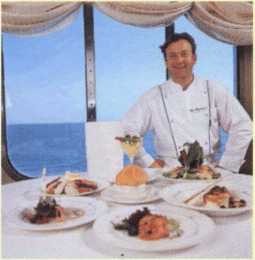
Joseph Jungwirth, corporate executive chef, Royal Caribbean International (RCI): “We are putting tremendous focus on seeking out new ideas and investigating the market to meet our guests’ wishes. But at the end of the day people enjoy the basics while they will also try out new culinary adventures. It is almost like fashion, except that food trends do not change every year.”
Toni Egger, corporate executive chef, Seabourn Cruise Line: “We are introducing entirely new dinner menus designed by Charlie Palmer, the founder of Aureole in New York. Charlie has created more than 200 new recipes. The food is creative and innovative, without being too radical. The key differences are bold flavors based on reductions and infusions, rather than cream-based sauces and heavier techniques used in the past. It is very satisfying food.”
Franck Garanger, corporate chef, Silversea Cruises: “For 2002, we will have 14 Relais & Chateaux guest chefs from all over the world. We have also implemented an “Amuse Bouche” cycle for serving at our officers’ tables on formal nights. We surprise guests with an unexpected little plate before starters, featuring sauteed foie gras or scallops wrapped in nori sheet, turbot with smoked duck, etc. – in total 14 new recipes. During the summer we will review our complete dessert cycle with two renowned pastry chefs from France, Michel Galloyer and Simon Olivier. In total more than 80 new recipes will be implemented.”
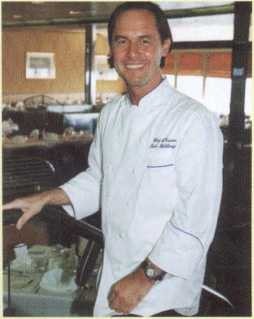
Stefan Heuser, general manager, catering services, V. Ships: “One of the traditional ships under our management now offers a ‘fun cruise’ concept during the summer season, catering to younger passengers. They prefer simpler food. They are also more experimental. Food is served in multiple locations. We make more use of the open decks where we incorporate the ‘fun’ concept into BBQs and picnic style lunches.”
Frank Ulbricht, food and beverage manager, Windstar Cruises: “We have implemented a new set of Patina recipes.” What do you see as industry trends and what is your opinion?
Poirier (Apollo): “Flexibility is the way to go. At Renaissance Cruises, we opened all the restaurants at the same time: three formal and one casual. We went from the two classical seatings to open seating.”
Leypold (Carnival): “We believe in the ‘fresher is better’ concept. All of our fruit and vegetables are fresh and most of the fish we serve for dinner is fresh. We offer four seatings for dinner, extended Lido and Seaview Bistro hours, 24-hour pizzeria as well as 24-hour stateroom service. We are offering more variety of selected seafood (lobster, shrimp, crab and fresh fish) and poultry (squab, game hen, ostrich, quail, duck, etc.) as well as vegetarian dishes.”
Neumeister (Crystal): “We (the industry) are getting better and better. I think the trends are fantastic – they represent a continuous dramatic improvement from the past. Sushi is becoming very popular. Six or seven years ago, not many people ate raw fish, now they all seem to. We employ a highly trained Japanese chef aboard our ships. My belief is to always listen to the guests. I also sit down with the maitre d’s and the headwaiters to learn what the guest like or don’t like and we build the feedback into the menus.”
Muhlberger (Cunard): “More choices in dining; ethnic cuisine is in strong demand. Flavor is in; bland is out. Curry is popular and so is Sushi. We have a Japanese chef aboard our world cruise. The gap between gourmet and everyday cuisine is closing. Some guests now prefer a more casual dinner. Our bistro buffet is very popular. At the same time, desserts are becoming more important. Pastry chefs will be very important in the future.”
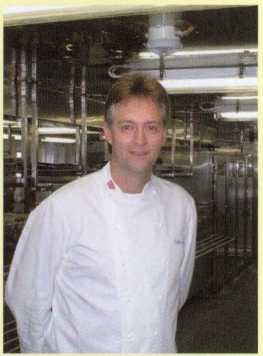
Gruebel (HAL): “There is lots of meaning and support behind changes. But we look at our passenger profile and listen to what they tell us. If we get too trendy, we get negative vibes from a certain percentage of our passengers right away. It is difficult to start breaking up the dining rooms for open seating; the rooms will not look right and lose their warm atmosphere. However, we have added alternative dining rooms to our new ships and we open up the Lido for simple steak dinners. We are also adding alternative dining rooms on two of our older ships.”
Sinowatz (Ligabue): “The industry should define their passengers better. It is easier to please passengers who share the same interests and preferences. I would prefer either all upscale passengers or all budget passengers on a ship. To please both at the same time is impossible. In addition, the two groups would not enjoy each other either.”
Tobler (NCL): “The principles of classical cuisine are back again. We offer adequate portions; we use more fresh ingredients; we use more seafood; and we feature lighter cuisine. Noodle dishes are popular. Smoked foods are back and salsa is so trendy it can be used for almost anything. Unexpected condiments are also popular as are artisan types of breads.”
Marzi (Princess): “Princess will continue to set trends which will be less about a single unique item and much more about the total experience. Trends will revolve around delivering choice through the variety and quality of our food, beverage and service operation.”
Klotz (Radisson Seven Seas): “Guests dine healthier and are more knowledgeable about international cuisines and wines.”

Jungwirth (RCI): “Today’s passengers expect to have dining options; they are expecting less scheduling of their ‘time’ and want the flexibility they would have at a resort.”
Egger (Seabourn): “We are basically bringing the finest cuisine from ashore onto our ships. It is a translation that has not been done before. Frankly, I think Charlie initially had his doubts, until he saw the facilities and the level of chefs we employ. Now he is a believer too.”
Garanger (Silversea): “Guests look for more local food related to the cruise. On a recent cruise, we bought some fantastic fresh local Mediterranean Sea bass in Taormina and were able to offer whole grilled sea bass to three different tables every night during the whole cruise.”
Heuser (V. Ships): “The large size of the new vessels requires that they offer everything to everybody. They offer super luxury suites and inside four-bed cabins on the same ship. Obviously dining expectations among passengers will vary greatly.”
Ulbricht (Windstar): “The industry is going towards lighter and healthier food. The passengers are more careful about what they eat and how much they eat. Especially the vegetarian trend is very much present.”
What changes do you see in the passengers, if any, and if so, has this affected menus?
Poirier (Apollo): “Younger passengers demand more choices. Hence, we have the alternative restaurants on the Millennium-class ships, which are the best of their kind I have seen – in terms of service, food, silverware, crystal, and table linen, as well as wine.”
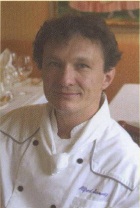
Leypold (Carnival): “We evaluate guest feedback and keep track of their eating habits. Dishes that are not popular will be substituted.”
Jorgensen (Fred. Olsen): “More vegetarian passengers. Out of 700 passengers, it is not uncommon that 35 to 40 are vegetarians. Otherwise, eating habits have not changed much. People go to have a good time. They eat all the good stuff.”
Muhlberger (Cunard): “The amount of food consumed at sea used to give ships a bad name. But people are not eating as much anymore. They look for smaller portions and better presentation. Now people typically choose three or four courses instead of five or six as before.”
Gruebel (HAL): “The passengers are changing all the time. We always had passengers ranging from those with very high expectations to those with low expectations. Now there are more people that have grown up with hamburgers; they expect to eat their salad with the meal, not before the meal. We must adapt to that and be flexible so we can accommodate everybody.”
Sinowatz (Ligabue): “Passengers are more health conscious. But this does not mean that we replace hamburgers with steamed vegetables. Instead, health food to us means top quality ingredients, natural and fresh products, well balanced and prepared on the highest level. The result is healthy food.”
Marzi (Princess): “The greatest change in passengers is that there are more and more of them. They come from all over the world with all kinds of backgrounds. The effect on the menus is choice, offering a wide variety of quality products that will appeal to everyone.”
Klotz (Radisson Seven Seas): “We have more requests for therapeutic food, various diets and lifestyle eating philosophies.”
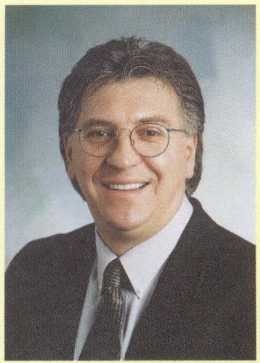
Jungwirth (RCI): “They are getting younger, and as with shoreside restaurants, our menus are driven by demand.”
Egger (Seabourn): “Our guests come to us with wider culinary experiences. They are finding new styles of cooking in the better restaurants ashore and they expect us to deliver it onboard.”
Garanger (Silversea): “Guests are more open to international cuisines, spices and Asian flavor, but they also want to find simple foods on the menu.”
Heuser (V. Ships): “Passengers are becoming more educated about food. They will ask whether the food was organically grown or whether it was genetically altered. People try to eat healthier and are eager to experience local and ethnic foods indigenous to the country or area the cruise takes them to.”
Ulbricht (Windstar): “Our guests are experienced travelers who expect to find local specialties on the menus, as well as local wines being offered with the meals. We have many repeat passengers and they want to experience new tastes and new choices. Our onboard chefs can change the menus on a daily basis, depending on product availability, and passenger demands, as well as the region we are sailing in.”
What are the challenges and issues you face as executive chef?
Poirier (Apollo): “Hiring: we have to recruit and train new cooks and chefs. Back in the 80s when we would advertise for crew we would get 500 responses. Today, we only get a fraction of that.”
Leypold (Carnival): “Our main goal is to please our guests and to make them want to return to Carnival. Every crew member in the hotel operations department is interviewed by a senior man-ager prior to hiring and undergoes a four- week training program. Investing in new technology and training, being receptive to new ideas and trends, and working together with suppliers, keeps costs under control.”
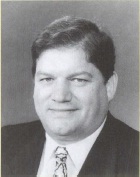
Neumeister (Crystal): “To keep middle management. The company pays well, offers year-round employment, and shorter contracts. It may cost more, but in the long run it will cost even more if you have to hire and train all the time. And, we never sacrifice quality over cost. What you can do is to look for a better deal from your supplier and plan smarter. The industry needs to educate the suppliers. We need quality, not quantity. In the luxury market, quality always comes first.”
Muhlberger (Cunard): “Food cost is not a challenge if you buy properly and use the ingredients efficiently. Pineapples and papayas for instance are cheap where they grow, but valuable at sea, so on a ship you learn to peel them carefully. Nor is recruitment a problem. Money talks as they say. We pay people well and we treat them well. Ninety percent of our cooks go through our ‘culinary college at sea’ on the QE2. Our commitment to the crew has reduced turnover by 50 percent.”
Jorgensen (Fred. Olsen): “To find the right chef for the right position. The food is very important at Fred. Olsen. We score very highly in the passenger satisfaction ratings, so we try very hard to find the right crew. Compared to working ashore where your work day is set by law and you have two days off every week, on a ship we work three to four months straight.”
Gruebel (HAL): “The biggest challenge is to keep your crew. I believe in training. You train within your organization and you make every effort to keep your people. You support them and you help them so they in turn will help you. We must also be ready to share our knowledge with the younger generation to give them the opportunity to move up.”
Sinowatz (Ligabue): “You need good quality, seasoned ingredients, awareness and control of the material to prevent spoilage, the best preparation, and appropriate portions. If you follow these rules, your quality will be the best and you will stay within your budget too.”
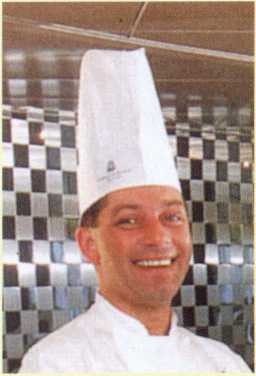
Tobler (NCL): “The biggest challenge is to find qualified crew. But we do not cut back on quality. Instead, scale is helping us cut cost. With a bigger fleet and by combining the purchasing of three cruise brands, we can buy the same quality at lower prices.”
Marzi (Princess): “The challenges are great, but so are the results. Imagine one of the world’s most luxurious hotels. Now imagine that it floats in the middle of the ocean. Serving the best food while maintaining cost structures is a great balance of stringent purchasing specifications for every one of the markets we sail in, state-of-the-art equipment and facilities, and the best trained and most talented staff.”
Klotz (Radisson Seven Seas): “The challenge is between the older, experienced travelers and the younger generation of travelers. It is important to find the right balance between modern and traditional dishes.”
Jungwirth (RCI): “Cutting costs never starts in the galley. The company negotiates prices with suppliers and enters into long-term contracts. We also know the quality and specifications we need. The combination ensures that we receive the quality we want, if not better, and keep within our budgets as well. In addition, we are also constantly tweaking our menus to invest savings from one item into upgrading another item.”
Egger (Seabourn): “The key to economy is not in compromising quality, but in cutting waste. This is where we concentrate in terms of economy. Menus, portions and preparations are all constantly monitored to improve efficiency.”
Garanger (Silversea): “We control costs by getting the best price from our suppliers, but not by cutting quality. We recruit many chefs and cooks from the restaurant business and not so much from the cruise industry. We would like to be different in the area of cuisine and that is the reason for our alliance with Relais & Chateaux.”
Heuser (V. Ships): “The key to preparing and serving better food depends to a large extent on purchasing. Our chefs are challenged to use products that are in season and we encourage them to serve regional specialties. We operate all over the globe and this requires a different approach. Due to the remoteness and product limitations, we depend on working with locally available products and adapt our menus accordingly.”

Ulbricht (Windstar): “We have one of the highest food budgets in the industry. We always offer fresh and cooked-to- order food which leaves us very few leftovers. Our executive and sous chefs attend training at the CIA in Napa Valley as well as the Patina restaurant. Our Filipino staff undergo continuous training onboard and our dining room stewards get their basic training at the S/S Jakarta school, which is run by Holland America Line in Jakarta.”
What are your “keys” to serving up the “best ” food (and providing passengers with that all-important dining experience, which for most may be the highlight of their cruise)?
Poirier (Apollo): “We never cheat the passengers. Proper preparation is one of the keys. Every dish has been thoroughly tried out in our own shoreside test kitchen. Fresh cheeses are flown in from Paris every week. We have our own bakery on board. We make our own tomato sauce for pizza. We care about our food. We follow Michel Roux’ ideas and convert his recipes from serving four people, for example, to 50. But food is not mathematical, you cannot just add 12.5 times more ingredients. The proportions change as you increase the servings. The galley is organized so every dish is made just in time literally to each passenger’s order.”
Leypold (Carnival): “Using the best possible ingredients and having well trained, motivated and happy crew members.”
Neumeister (Crystal): “I strongly believe that you start in the kitchen by using the best ingredients. In addition, you must have professional people and you must keep them. We have two customers: the guests and the crew. You must remember the crew when they do a good job, provide positive and negative feedback, and celebrate with them when they have done a wonderful job.”
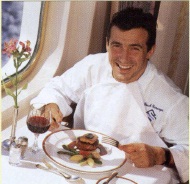
Muhlberger (Cunard): “It is very straightforward: you provide a consistent level of quality food and service. We listen to our guests. We also try to focus on the main ingredient of the dish itself and not to cover it with too many garnishes. The ingredients shall complement each other, not just be lined up on the plate.”
Jorgensen (Fred. Olsen): “To have the right people onboard. Most of our crew have been with us five or six years. It is also important to change the menus every so often and to find the right suppliers. We try to stay up to date on all the new trends; our goal is to be the best in a four- to five- star range.”
Gruebel (HAL): “Ingredients and staff. Performance makes the difference. Everybody must work as a team from the chef to the dishwasher. We do not pre-plate or pre-cook, unless we are serving a roast, for instance; we basically cook to order whether it is fish, steak or chops. Our service may be a little slower, but we put the freshest product on the plate when we serve. One of our chefs is one of the finalists in a cook-off competition at the National Restaurant Association trade show in Chicago (May). He will prepare a recipe for duck.”
Sinowatz (Ligabue): “To personalize the meals and the service to the passengers. If I know the likes and preferences of a passenger, I can make him or her feel like royalty.”
 Tobler (NCL): ‘‘Motivated staff who are not only doing their job, but having fun doing it. That in turn requires competent management. We have increased our corporate presence onboard and we offer more training. As we go along, we all learn more and make adjustments to make our product even better. The feedback from the crew is very important. Management must be open-minded and flexible. We must work with the front of the house in consultative and participatory ways. There is no more back of the house. Every person provides some kind of service to the guest.”
Tobler (NCL): ‘‘Motivated staff who are not only doing their job, but having fun doing it. That in turn requires competent management. We have increased our corporate presence onboard and we offer more training. As we go along, we all learn more and make adjustments to make our product even better. The feedback from the crew is very important. Management must be open-minded and flexible. We must work with the front of the house in consultative and participatory ways. There is no more back of the house. Every person provides some kind of service to the guest.”
Marzi (Princess): “The cuisine of Princess Cruises is a direct result of the combined culinary talent, experience in leadership and love for food demonstrated daily by our 3,000 food and beverage professionals. The only thing you have to add is a healthy dose of passion for what you do.”
Klotz (Radisson Seven Seas): “Our people. On our cruises we highlight seasonality and local ingredients, and the menu reflects the area where the ships are sailing. Our culinary style is drawn from the different nationalities of chefs we have onboard, regional specialties, classic haute cuisine and unique combinations of exotic ingredients prepared with traditional techniques. This adds up to the characteristic style of Radisson cuisine and gives our guests an extraordinary dining experi-ence.”
Jungwirth (RCI): “Fresh, fresh and fresh! Using the best available produce and preparing it in regular batches or what you would call ‘banqueting a la minute.’ Our alternative dining quite easily competes with some of the best five-star restaurants ashore.”
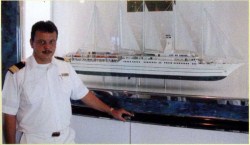 Egger (Seabourn): “The key is to know your guests. Because we serve so few guests, we can concentrate on them and tailor our service to their particular tastes. Our wait staff is highly trained to notice and record the preferences and dislikes of our guests. What may seem like magic to our guests is actually the result of a lot of work and concentration.”
Egger (Seabourn): “The key is to know your guests. Because we serve so few guests, we can concentrate on them and tailor our service to their particular tastes. Our wait staff is highly trained to notice and record the preferences and dislikes of our guests. What may seem like magic to our guests is actually the result of a lot of work and concentration.”
Garanger (Silversea): “Constant re-search for improvement of new techniques and new food items; motivated galley team; listening to our guests; and always thinking one step ahead of our competitors.”
Heuser (V. Ships): “It seems to be a general rule that 85 percent of our guests are relatively easily pleased. Our goal is to completely satisfy the remaining 15 percent who have very special needs. That can only be achieved by identifying their needs and communicating them between front and back-of-house staff. Among the vessels that we manage is one expedition vessel that spends two months per year cruising the Amazon River. The passengers have come to experience other cultures. So every week we change the dining room into a typical Brazilian Churrascaria.”
Ulbricht (Windstar): “It is very simple: all the food has to be prepared as late as possible and as much a la minute as possible. The fresher the food, the better it tastes.”




